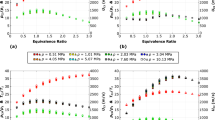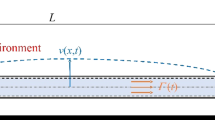Abstract
Hot gas ingestion refers to the phenomenon of mainstream hot gas flowing into the space cavity of a turbine wheel. Previous studies have found that mainstream annulus pressure distribution plays an important role in hot gas ingestion, but due to its complexity, the mechanism of the interaction between mainstream flow and hot gas ingestion remains unclear. This paper adopts the URANS method, and three sealing flow rates are considered, named Cw=0, Cw=500, and Cw=5000. The time-averaged annulus pressure distribution shows that an increase in the sealing flow decreases the pressure value, and the effects of the sealing flow on the pressure distribution of the leading edge of the blade are much more influential than that of the trailing edge of the vane. The unsteady pressure time-space distribution in the annulus indicates that a time-space tilted distribution of pressure at the rim exits when the sealing flow exists. This phenomenon is mainly due to the strong feedback mechanism of the sealing flow to the annulus pressure field. A comparison of the pressure and mean radial velocity distribution of the mainstream shows that the ingestion mainly occurs on the blade side, where the pressure is lower than on the vane side. The flow characteristics at the wheel rim are analyzed with a sealing flow rate Cw=5000, and under these conditions, both pressure-induced ingestion and ingestion caused by a passage vortex can be inferred. The three-dimensional and inertial effects of the mainstream at the wheel rim lead to the generation of separation vortices on the blade side, and the presence of separation vortices leads to ingestion along the blade side. At the same time, pressure on the blade side will cause the fluid to have a radial inward flow tendency, which will promote the formation of separation vortices, leading to more serious ingestion in the high-pressure region on the blade side. The blade pressure field can be more significant than the vane trailing pressure field in the rim seal ingestion, and it contributes some explanations to the open question: the effect of blade on ingestion.
Similar content being viewed by others
Abbreviations
- b :
-
outer radius of disk cavity/mm
- C p :
-
dimensionless pressure coefficient, Cp=(p−pavg)/q
- C w :
-
dimensionless sealing flow rate, Cw=m/µb
- ΔC p :
-
dimensionless peak-trough pressure difference in the annulus, ΔCp=Cpmax−Cpmin
- m :
-
mass flow rate/kg·s−1
- p :
-
local static pressure/Pa
- p avg :
-
line average static pressure across two pitches/Pa
- q :
-
dynamic pressure of fluid at axial velocity in the annulus/Pa, q=ρW2/2
- Re ϕ :
-
disk rotational Reynolds number, Reϕ=ρΩb2/μ
- T :
-
time for one blade passing period/s
- t :
-
time/s
- U :
-
hub speed/m·s−1, U=Ωb
- V :
-
total speed/m·s−1
- V r :
-
local radial velocity/m·s−1
- \({{\bar V}_{\rm{r}}}\) :
-
circumferential average radial velocity/m·s−1
- \({{\bar V}_{\rm{r}}}/U\) :
-
dimensionless radial average velocity by hub speed
- W :
-
axial velocity in the annulus/m·s−1
- W s :
-
streamwise vortex
- X :
-
axial coordinates from the vane trailing to the blade leading edge/m
- θ :
-
normalized tangential coordinate between two vanes
- μ :
-
dynamic viscosity/Pa·s
- Ω :
-
rotating disk angular speed/rad·s−1
References
Bayley F.J., Owen J.M., The fluid dynamics of a shrouded disk system with a radial outflow of coolant. Journal of Engineering for Power, 1970, 92(3): 335–341.
Chew J.W., A theoretical study of ingress for shrouded rotating disk systems with radial outflow. Journal of Turbomachinery, 1991, 113: 91–97.
Chew J.W., Dadkhah S., Turner A.B., Rim sealing of rotor-stator wheelspaces in the absence of external flow. Journal of Turbomachinery, 1992, 114(2): 433–438.
Campbell D.A., Gas turbine disc sealing system design. AGARD Seal Technology in Gas Turbine Engines, 1978.
Kobayashi N., Matsumato M., Shizuya M., An experimental investigation of a gas turbine disk cooling system. Journal of Engineering for Power, 1984, 106(1): 136–141.
Phadke U.P., Owen J.M., Aerodynamic aspects of the rim sealing of gas turbine rotor-stator systems parts 1–3. International Journal of Heat and Fluid Flow, 1988, 9: 98–117.
Dadkhah S., Turner A.B., Chew, J.W., Performance of radial clearance rim seals in upstream and downstream wheelspaces. Journal of Turbomachinery, 1992, 114(2): 439–445.
Hamabe K., Ishida K., Rim seal experiments and analysis of a rotor-stator system with nonaxisymmetric main flow. Turbo Expo: Power for Land, Sea, and Air, American Society of Mechanical Engineers, 1992, 78934: V001T01A060.
Owen J.M., Prediction of ingestion through turbine rim seals-part I: rotationally induced ingress. Journal of Turbomachinery, 2011, 133(3): 1–9.
Owen J.M., Prediction of ingestion through turbine rim seals-part II: externally induced and combined ingress. Journal of Turbomachinery, 2011, 133(3): 1–9.
Owen J.M., Zhou K., Pountney O., et al., Prediction of ingress through turbine rim seals: part 1—externally-induced ingress. Journal of Turbomachinery, 2012, 134(3): 1–13.
Green T., Turner A.B., Ingestion into the upstream wheelspace of an axial turbine stage. Journal of Turbomachinery, 1994, 116(2): 327–332.
Sangan C.M., Zhou K., Owen J.M., et al., Experimental measurements of ingestion through turbine rim seals: part 1—externally-induced ingress. ASME Turbo Expo: Turbine Technical Conference and Exposition, GT2011: 741–753.
Chew J.W., Green T., Turner A.B., Rim sealing of rotor-stator wheelspaces in the presence of external flow. Turbo Expo: Power for Land, Sea, and Air, American Society of Mechanical Engineers, 1994, 78835: V001T01A041.
Hills N.J., Chew J.W., Turner A.B., Computational and mathematical modelling of turbine rim seal ingestion. Journal of Turbomachinery, 2002, 124(2): 306–315.
Bohn D., Johann E., Krüger U., Experimental and numerical investigations of aerodynamic aspects of hot gas ingestion in rotor-stator systems with superimposed cooling mass flow. Turbo Expo: Power for Land, Sea, and Air, American Society of Mechanical Engineers, 1995, 78781: V001T01A034.
Bohn D., Rudzinski B., Sürken N., et al., Experimental and numerical investigation of the influence of rotor blades on hot gas ingestion into the upstream cavity of an axial turbine stage. Turbo Expo: Power for Land, Sea, and Air, American Society of Mechanical Engineers, 2000, 78569: V003T01A088.
Bohn D.E., Decker A., Ma H., et al., Influence of sealing air mass flow on the velocity distribution in and inside the rim seal of the upstream cavity of a 1.5-stage turbine. Turbo Expo: Power for Land, Sea, and Air, 2003, 36886: 1033–1040.
Wang C.Z., Johnson B.V., De J.F., et al., Comparison of flow characteristics in axial-gap seals for close-and wide-spaced turbine stages. Turbo Expo: Power for Land, Sea, and Air, 2007, 47934: 1219–1229.
Roy R.P., Xu G., Feng J., et al., Pressure field and main-stream gas ingestion in a rotor-stator disk cavity. Turbo Expo: Power for Land, Sea, and Air, American Society of Mechanical Engineers, 2001, 78521: V003T01A089.
Roy R.P., Feng J., Narzary D., et al., Experiments on gas ingestion through axial-flow turbine rim seals. Journal of Engineering for Gas Turbines and Power, 2005, 127(3): 573–582.
Hualca F.P., Horwood J.T.M., Sangan C.M., et al., The effect of vanes and blades on ingress in gas turbines. Journal of Engineering for Gas Turbines and Power, 2020, 142(2): 021020.
Graikos D., Carnevale M., Sangan C.M., et al., Influence of flow coefficient on ingress through turbine rim seals. Journal of Engineering for Gas Turbines and Power, 2021, 143(11): 111010.
Xie L., Wang R., Liu G., et al., Numerical investigation on unsteady characteristics in different rim seal geometries: part A. Turbo Expo: Power for Land, Sea, and Air, American Society of Mechanical Engineers, 2020, 84188: V07CT14A013.
Lian Z., Du Q., Liu G., et al., Numerical investigation on unsteady characteristics in different rim seal geometries: part B. Turbo Expo: Power for Land, Sea, and Air, American Society of Mechanical Engineers, 2020, 84072: V02BT33A025.
Wang R., Du Q., Liu G., et al., Influence of secondary sealing flow on performance of turbine axial rim seals. Journal of Thermal Science, 2020, 29: 840–851.
Wang R., Liu G., Du Q., Lian Z., Xie L., An improved control method of rim seal based on auxiliary sealing holes. GPPS, Beijing, China, Sep 2019, pp: 16–18.
Du Q., Wang R., Xie L., et al., A novel design of rim sealing flow for improving sealing effectiveness. Journal of Engineering for Gas Turbines and Power, 2023, 145(7): 071003.
Xie L., Du Q., Liu G., et al., Investigation of unsteady flow characteristics in axial rim seal. Turbo Expo: Power for Land, Sea, and Air, American Society of Mechanical Engineers, 2021, 84980: V05BT14A002.
Cheng S., Li Z., Li J., Investigations on the sealing effectiveness and unsteady flow field of 1.5-stage turbine rim seal. Journal of Engineering for Gas Turbines and Power, 2019, 141(8): 081003.
Xie L., Du Q., Liu G., et al., Flow characteristics in turbine wheel space cavity. Energy Reports, 2021, 7: 2262–2275.
Bohn D.E., Decker A., Ohlendorf N., et al., Influence of an axial and radial rim seal geometry on hot gas ingestion into the upstream cavity of a 1.5-stage turbine. Turbo Expo: Power for Land, Sea, and Air, 2006, 4238: 1413–1422.
Schuepbach P., Abhari R.S., Rose M.G., et al., Sensitivity of turbine efficiency and flow structures to varying purge flow. Journal of Propulsion and Power, 2010, 26(1): 46–56.
Scobie J.A., Hualca F.P., Sangan C.M., et al., Egress interaction through turbine rim seals. Journal of Engineering for Gas Turbines and Power, 2018, 140(7): 072504.
Acknowledgments
The authors wish to acknowledge the financial support of the National Natural Science Foundation Outstanding Youth Foundation (Grant No. 52122603), the National Science and Technology Major Project (J2019-III-0003-0046) and the cloud computing supported by the Beijing Super Cloud Computing Center.
Author information
Authors and Affiliations
Corresponding authors
Ethics declarations
On behalf of all authors, the corresponding author states that there is no conflict of interest.
Rights and permissions
About this article
Cite this article
Ren, R., Du, Q., Liu, G. et al. Influence of Vanes and Blades on Ingress in Axial Rim Seal for Turbine Stages. J. Therm. Sci. 33, 833–846 (2024). https://doi.org/10.1007/s11630-024-1986-0
Received:
Published:
Issue Date:
DOI: https://doi.org/10.1007/s11630-024-1986-0




